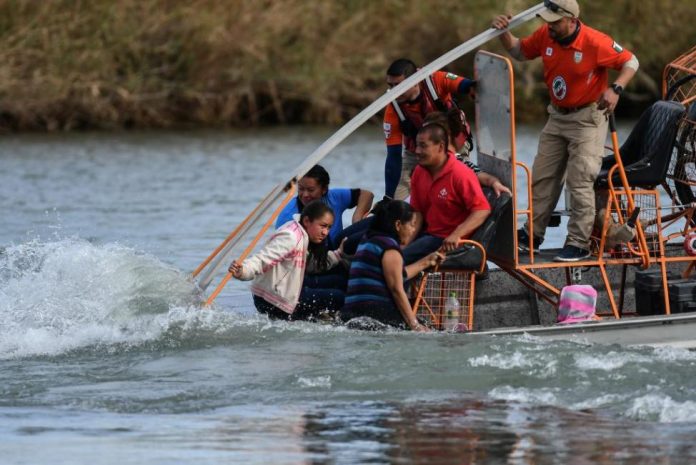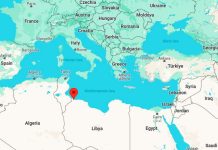
“The migrants are desperate,” said Obed Cuellar, a Catholic missionary who directs a church-run shelter across the river in Piedras Negras, Mexico. “They don’t measure the risks or consequences of crossing the Rio Grande. They have it in their heads they are going to get to the United States by any possible means.”
Ramsey English Cantu, mayor of Eagle Pass’ 29,000 residents, said about 800 people have been rescued from the river this month.
On Friday, Border Patrol agents recovered a man’s dead body from the river and on Saturday rescued a Guatemalan father and son who “began to struggle to stay afloat in swift current.” In one week in mid-February, U.S. Border Patrol agents retrieved the body of a unidentified dead man near a downtown international bridge; rescued 17 people from the river in three incidents at the same location; and resuscitated a 12-year-old Honduran boy they pulled from the river.
“The 12-year-old boy had already lost consciousness and was underwater. Agents pulled the boy’s limp body onto the vessel and resuscitated him with CPR,” the Border Patrol said.
Barred from point of entry
U.S. Customs and Border Protection increased security at the border in response to a 2,000-member migrant caravan that left Central America in mid-January, headed for Eagle Pass.
By the time the caravan arrived on Feb. 4, CBP had brought in more agents and added support from 250 U.S. soldiers and 500 Texas state troopers. They laid concertina wire on the bridges and deployed riot police for drills on how to handle migrants rushing the port of entry.
With that route effectively blocked, river crossings became the preferred alternative for migrants.
Border Patrol agents and Texas state troopers positioned trucks on the river’s banks, lights flashing, in a show of force to discourage them from entering the water.
“It’s always been dangerous. The current is strong in some areas,” said Alexa Tavarez, a student in public policy at the University of Texas at Austin who was born in Eagle Pass. “It’s running water. It’s not just a puddle to jump over.”
Maverick County Sheriff Tom Schmerber, who visited Piedras Negras after the caravan’s arrival, said Mexican authorities told him they were taking groups of detained migrants to the river to show them the buildup of law enforcement.
“We told them, ‘They are going to apprehend you, anyway. Don’t cross the river,'” Schmerber said.
CBP said it hardened the ports of entry fearing a repeat of what happened in November in Tijuana, Mexico, where thousands of migrants attempted en masse to enter the United States at the San Ysidro, Calif., port of entry.
But unlike in Tijuana, where U.S. agents tear-gassed migrants at the border, authorities in Piedras Negras tried to stop migrants from reaching the international line. They detained caravan members in an abandoned factory. Mexican police refused to let 1,800 migrants without humanitarian visas leave.
“This wasn’t a situation [Mexico’s authorities] would have asked for,” said Michael Hudak, acting chief U.S. Border Patrol agent of the Del Rio sector, which includes Eagle Pass. “But they kept them safe.”
Locked in a shuttered factory-turned-detention center, the migrants became more frustrated and started violent protests. Some were arrested and ordered deported. When the center closed Feb. 19, most migrants had been bused to other cities.
The day after the detention facility closed, Hudak said, a greater number of migrants were being rescued from the river.
Long wait for asylum
Even though Mexico’s authorities moved hundreds of migrants to other cities, a significant number still arrive in Piedras Negras and wait for asylum interviews with U.S. officials. More than 300 people are on a waiting list maintained by city officials.
“U.S. Customs and Border Protection did not change the number of people dedicated to processing people requesting asylum at the international bridges,” said Stephanie Leutert, director of the Mexico Security Initiative at the University of Texas at Austin, who last year published a report on how the Trump administration is “metering” migration by turning them back to Mexico. “The surge in officers was anything but a humanitarian response.”
Thousands of commuters on foot and in vehicles cross the two international bridges into Eagle Pass each day, but anybody without valid U.S. travel documents cannot get past sentries placed at the midpoint of the spans.
“They say that if they can’t cross the bridges, they will take their chances in the river,” said Cuellar, who has worked with migrants for 20 years and never seen such desperation. “When they are desperate, they don’t think. They just launch themselves into the river.”
Shelters in Piedras Negras, a city of 250,000 residents, are in such high demand they can only offer migrants a stay of two or three nights. The city government and the state of Coahuila have stopped providing migrant support, Cuellar said. That pushes them to attempt a river crossing.
“We tell them not to try to swim the river,” said Hector Menchaca, the Piedras Negras official who acts as a liaison with U.S. authorities, keeping the asylum appointment waiting list.
If they enter the river and are caught by Mexican authorities, they are returned to a shelter. Some migrants try three or four times before they reach the U.S. side, Cuellar said.
Eddie Moreno, a retired shop owner who has lived in Eagle Pass for 20 years, said he sometimes sees refugees in the water when he’s playing golf at the park between the international bridges.
“We see migrants coming across the river all the time,” he said. “If 1,800 people walked across this golf course, I would let them go. They have the same rights as I do. They just want a better life.”



